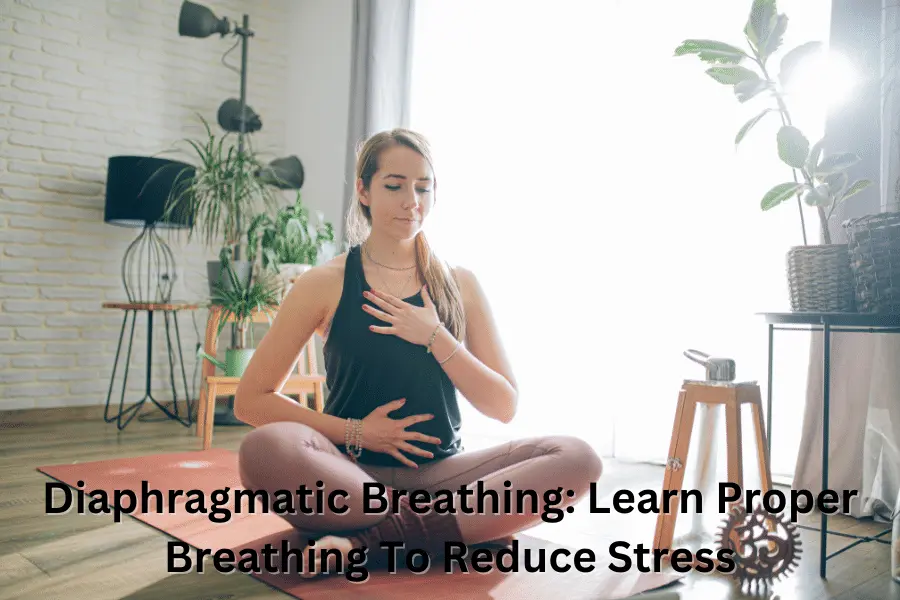Maybe you are a curious person who wants to know which of the different breathing exercises helps to improve the health of your lungs. Well, thank you stars because your search has brought you to the right place. Have no fear. We do not intend to bore you with all the breathing exercises here, only the ones people commonly practice. The common ones that are practiced are diaphragmatic breathing and chest breathing. We will also give our focus to breathing mechanics in general.
This blog post will help to unravel the patterns of belly breathing vs chest breathing.
Belly Breathing vs Chest Breathing
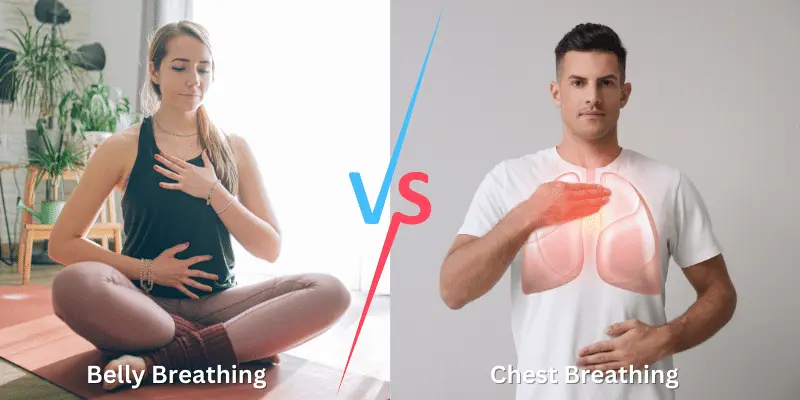

A simple breathing activity involves drawing air in and out of your lungs. This varies in pressure though. Inhalation, also called inspiration, happens when you draw air into the lungs. This act you do causes a fall in air pressure. Exhalation, which is also referred to as expiration, occurs when air is breathed out of your lungs. There is an increase in pressure in this situation. With this you can tell that inspiration and expiration are the two breathing mechanisms.
When inhalation takes place, wonders happen that you cannot see. The rib cage contracts to pull the ribs out and expand the chest cavity. The diaphragm contracts following this. What follows shortly after the contraction is the downward movement of the diaphragm and the contraction of its muscles. This causes the chest cavity to expand and a vacuum to be produced.
The exhalation process almost takes the same way as inhalation in the sense that the muscles attached to the ribs also contract. Unlike in the inhalation process, the abdomen is relaxed. In addition, the air pressure is increased. This makes air to be released through the lungs.
The two processes described above govern the exchange of gases in one’s respiratory system.
When you draw in minimal breath with the use of intercostal muscles, this is what chest breathing involves. As the name suggests, chest breathing makes use of one’s chest to breathe. In upper lobar breathing, air is drawn into the chest by raising the shoulders and collarbone and contracting the abdomen during inhalation. This way, a maximum amount of air can be drawn for short periods of time.
Let’s take a look at another breathing pattern in opposition to chest breathing. This is the belly breathing. This one uses the diaphragm to breathe. This allows air to enter the lungs. However, in this breathing pattern, the intercostal muscles in the chest do little. The belly expands to make room for this contraction.
Read Also: Seiza Meditation: A Complete Guide to This Buddhist Sitting Posture
Amazing Benefits of Diaphragmatic Breathing Unleashed
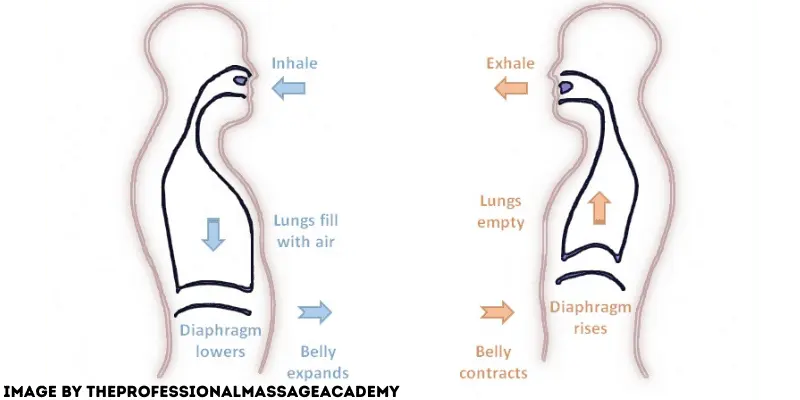

- It makes the diaphragm (which is a sheet of muscle just below the lungs) to be activated
- Encourages full oxygen exchange and slow exhalation to reduce hyperventilation. With regular deep breathing, the lungs expand and increase your ability to exercise for long periods of time. As you continue to practice such breathing, you will be able to fully utilize your pulmonary system.
- Stress hormones are lowered to trigger relaxation and calmness. Did you know that your immune system and general body function are tampered with when you are stressed? Deep breaths such as belly breathing keep stress at bay.
- It can foster pain relief. For instance, when you are in pain or tensed, your breath becomes rapid but when you take in deep breaths, you become calm and reduce your pain levels. To add to that piece of information, the brain releases endorphins which are pain relievers. During deep breathing, these chemicals are triggered to relieve pain.
- It slows down the breathing rate.
- Excess fluids, toxins, and wastes are flushed out from the body by means of breathing.
- Another huge benefit is that it allows your body to digest and strengthens your core.
- Let us not forget that it helps you stabilize your emotions and builds resilience.
Tips on How to Effectively Practice Diaphragmatic (Belly) Breathing
- Lay on your back with your hands on your belly. You could get a yoga mat for more comfort. Try to bend your knees so you will be firm. Keep your feet flat.
- Keep your body still and relaxed. Exhale in order to expel air in your lungs and maximize uninterrupted flow.
- Draw in air through your nose using your abdomen, not your chest. Let your rib cage and lungs to expand as you do so.
- Then, as if through pursed-lip breathing, open your mouth slowly. Let your abdominal muscles contract to remove carbon dioxide from your lungs.
If you are sitting upright:


- You still have to bend your knees to ensure firmness. Your neck and shoulders should be calm.
- After getting that position, place one hand on your chest and one hand on belly.
- Slowly inhale in such a way that your belly moves. Do not let the hand on your chest move with it.
- Tighten your stomach muscles and exhale.
– Practice these in short sessions (5 mins) 1-2 times per day and notice how you feel when you do.
Sample Diaphragmatic Breathing Exercises


- Basic belly breathing (inhale through nose, exhale through mouth)
- 4-7-8 breathing (inhale 4 secs, hold 7 secs, exhale 8 secs)
- Paired breathing (hands-on belly, inhale and exhale together with partner)
- Yogic breathing (incorporate yoga practice into your deep breathing practice)
- Anchor breathing (Make use of visualization as you perform diaphragmatic breathing)
- Square breathing (equalize the ratio of inhales, pauses and exhales during this exercise)
- Physiological sighs (break the cycle of anxiety with a sigh. A daily 5-minute practice of cyclic sighs can decrease stress and anxiety for 24 hours).
Benefits of Proper Diaphragmatic Breathing Unlocked
- It diminishes the effects of stress and anxiety: Chronic stress and anxiety can lead to disruption in normal breathing patterns. Proper diaphragmatic breathing can balance the breath system and improve one’s thoughts and feelings. It helps to lower the levels of stress hormones and increases attention rates in people.
- Lowers blood pressure and heart rate: Studies show that people who practice proper diaphragmatic breathing can help reduce their blood pressure by some 30 points. It has been concluded that is deep breathing practice may be a first treatment for those who are predisposed to hypertension.
- Resolve lung problems especially in patients with COPD: Breathing with the diaphragm helps tackle lung problems. Deep breathing is often taught in medical programs to help patients maintain lung health.
- It can help to address digestive issues. Problems such as constipation and diarrhea can be tackled.
- Improves sleep and energy: It enables you to make efficient use of your energy to breathe. This leads to less oxygen demand and greater stamina. That is why it is advised that those who perform exercises should breathe this way as they can strengthen their endurance. It can also increase the quality of sleep.
- May reduce symptoms of panic attacks, depression. This is because it stabilizes mood and releases chemicals that promote happy feeling in people.
- It improves core muscle stability by keeping you physically calm and functioning as it should.
- Although this one is not widely known, it can improve speech and stuttering. Deep breathing is used in speech therapy to help people improve their speech impediments. Reasons being that it promotes relaxation.
Tips on How to Make Diaphragmatic Breathing a Daily Routine


- Set reminders to practice at consistent times. You could make use of breathing apps as they provide reminders and guidance to help you keep up.
- Find trigger points to use belly breathing (ex: at red lights)
- Use imagery of filling balloon in belly then exhaling
- Practice first thing in morning and before bedtime
- Do not aim for long sessions immediately. You may get discouraged and even quit. Start small with just few minutes each day. Then you can gradually scale up. Duration does not matter at first, consistency does.
- You can pair up with a partner (a family member of friend) who is also interested in doing belly breathing. Knowing that you have someone you are accountable to can make it an interesting journey.
- Weave your deep breathing practice into an already existing routine. If you are the type that exercises or meditate on a regular basis, incorporating this would pose little problem. You could also practice it before you brush or bathe or during commercial breaks.
- Note down your progress. Ask yourself, ‘how do I feel after my breathing sessions?’ Take note of any changes whether positive or negative as they may make you continue in your practice.
What is chest breathing? An Overview
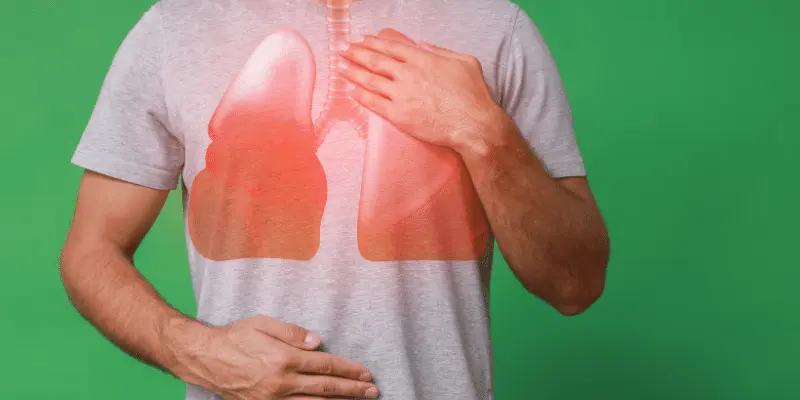

Chest breathing has been given so many names. You may have heard of shallow breathing, thoracic breathing or costal breathing. They are all the same thing. Chest breathing refers to the drawing of minimal breath into the lungs using muscles in the upper chest wall and rib cage (also known as the intercostal muscles) instead of the diaphragm. It is a normal breathing for many people.
Basically, chest breathing focuses on the rising and falling of the chest. It uses the movement of ribs to draw in and draw out air. The main muscles used when you inhale are the intercostals. Other muscles include spinal erectors, levator costartum and the serratus posterior. Chest breathing can be used to improve ribcage awareness and mobility and improve control of your breathing.
Chest breathing offers some benefits such as providing good foundation for the shoulders. It also provides awareness that diaphragmatic breathing is easier to learn. It may also improve neck posture and general posture. Another benefit is that it can help to differentiate movements of the chest or ribcage from those of the shoulders.
However, this pattern of breathing is considered less efficient and beneficial. It brings in less air as you inhale and it requires more effort. There are certain conditions that causes chest breathing or are caused by chest breathing:
- Anxiety and stress
- Asthma
- Hyperventilation or hypoventilation
- Pneumonia
- Shock and shortness of breath
- High blood pressure
- Pulmonary Edema
- A kind of disease called Chronic Obstructive Pulmonary Disease (COPD)
Abdominal breathing – An overview


“Belly breathing” or “diaphragm breathing” are other words for abdominal breathing. It is also called deep breathing. It is basically concerned with the movement of the diaphragm to aid respiration.
The benefits of abdominal breathing is bigger than you can imagine. It can help you manage your stress levels, lower blood pressure and help with other important body functions. This kind of breathing helps to calm the body and to help one concentrate on a person’s breath. When you do abdominal breathing, the abdomen expands with teach breath rather than the chest.
It also warms the hands and feet, boosts motivation and promotes good energy. When your muscles are tensed, abdominal breathing can reduce tension in the muscles. It is widely known that it can boost blood oxygenation while expending less effort.
There are certain health conditions that has been improved by abdominal breathing. These conditions include lung disease, diarrhea, constipation, asthma, stress and anxiety. It is easy to practice. It can be done anywhere in the home, the office, while you are walking or even running.
Of course, to learn how to do it properly, you will need some lessons. You can check out some helpful tips in this article. You may feel uneasy after practicing diaphragmatic breathing for the first time. When this happens, breathe more rapidly. Allow yourself to settle for some time after practicing it. If you are sitting, do not get up too soon as you may experience lightheadedness.
Breath Work for the Nervous System
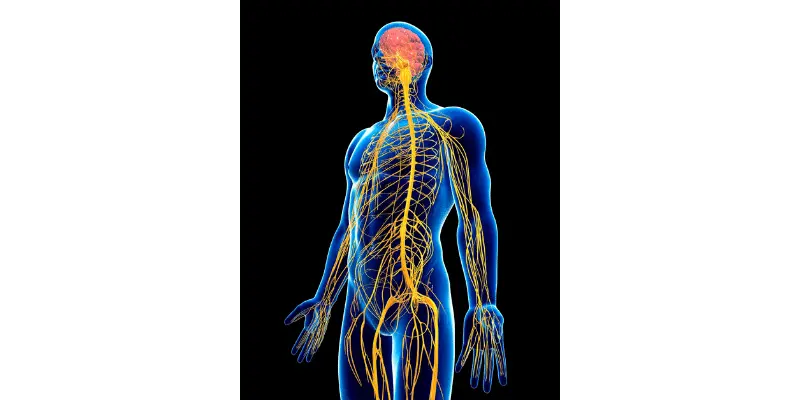

The function of the diaphragm affects the central nervous system. Breath work techniques have shown to benefit the nervous system, sending signal to the brain to keep you calm. Some of these techniques include:
- Box breathing: This also known as square breathing. It slows down your breathing to help you achieve greater sense of relaxation. To begin, you breathe out with your mouth on the count of four. You breathe in through your nose on the same count of four. But make sure your breath is coming from your stomach.
- Hum breathing: This method involves activating your vagus nerve. This activation turns off your internal alarm system and notifies your body that you are relaxed and safe. Hum breathing is done by breathing in through the nose and breathing out with a hum sound. Do these for about five to ten minutes. This can vibrate your vocal cords calm your breathing muscles.
Read Also: This 5-Minute Breath work Controls Your Nervous System like a Remote
How an Altered Breathing Pattern Causes Pain
Breathing, as simple as it is or as it may sound, has implications if not done right. In case you do not know, there is a right and wrong way to breathe. An altered breathing pattern can bring you neck pain, core stability issues and other serious problems that you wouldn’t have thought of. There are evidences to show that breathing pattern disorders contribute to problems such as motor control deficits which can result in diaphragmatic dysfunction.
Some persons who breathe the wrong way experience chest pain, chest tightness and breathlessness. They even suffer from poor posture and often have panic attacks. This often happens when chest breathing is practiced.
To conclude the debate of belly breathing vs chest breathing, it has been confirmed that belly breathing does more good for you than the latter. You should keep this mind and start paying attention to how you breathe.
FAQ’s:
Q. Which is better between belly breathing vs chest breathing?
A. Belly breathing is better as it properly fills your belly with air and creates negative pressure in the chest.
Q. What would you say is the most efficient breathing pattern?
A. Without a completion, diaphragmatic is the most efficient way to breathe. It is efficient because it gives you more stamina and endurance and regulates your heart rate.
Q. What are the side effects of chest breathing?
A. Some side effects associated with chest breathing include neck pain, headaches and even risk of injury. We could experience posture changes as well.
Q. Which do people say is better between diaphragmatic breathing vs chest breathing?
A. It is diaphragmatic breathing. Think of benefits such as blood pressure, circulation of oxygenated blood and energized feeling.
Q. Is it your goal to improve your general health?
A. Of course, everyone would love that. One good way to achieve that is to practice proper breathing pattern like the diaphragmatic breathing.

